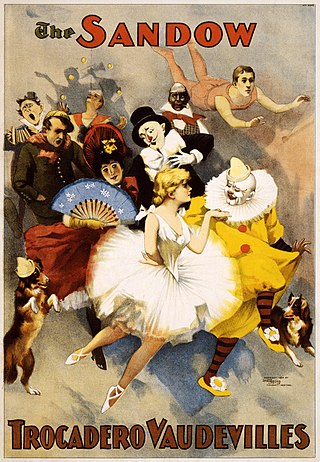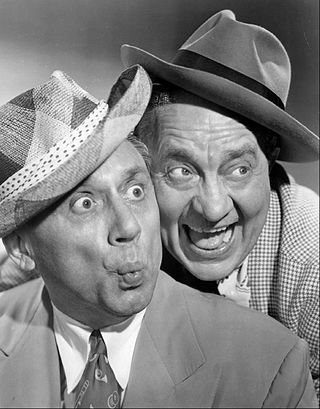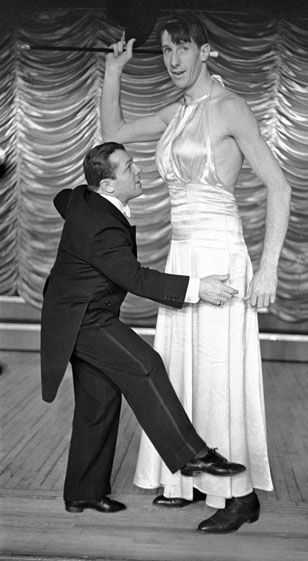Related Research Articles

Vaudeville is a theatrical genre of variety entertainment which began in France at the end of the 19th century. A vaudeville was originally a comedy without psychological or moral intentions, based on a comical situation: a dramatic composition or light poetry, interspersed with songs or ballets. It became popular in the United States and Canada from the early 1880s until the early 1930s, while changing over time.

Footlight Parade is a 1933 American pre-Code musical film directed by Lloyd Bacon, with songs written by Harry Warren (music), Al Dubin (lyrics), Sammy Fain (music) and Irving Kahal (lyrics). The film's numbers were staged and choreographed by Busby Berkeley. It starred James Cagney, Joan Blondell, Ruby Keeler and Dick Powell, with featured appearances by Frank McHugh, Guy Kibbee, Hugh Herbert, and Ruth Donnelly.
A prologue or prolog is an opening to a story that establishes the context and gives background details, often some earlier story that ties into the main one, and other miscellaneous information. The Ancient Greek word πρόλογος includes the modern meaning of prologue, but was of wider significance, more like the meaning of preface. The importance, therefore, of the prologue in Greek drama was very great; it sometimes almost took the place of a romance, to which, or to an episode in which, the play itself succeeded.

Evelyn Preer, was an African American pioneering screen and stage actress, and jazz and blues singer in Hollywood during the late-1910s through the early 1930s. Preer was known within the Black community as "The First Lady of the Screen."

The Paramount Theatre is a 2,807-seat performing arts venue located at 9th Avenue and Pine Street in the downtown core of Seattle, Washington, United States. The theater originally opened on March 1, 1928, as the Seattle Theatre, with 3,000 seats. It was placed on the National Register of Historic Places on October 9, 1974, and has also been designated a City of Seattle landmark.

The Roxy Theatre was a 5,920-seat movie palace at 153 West 50th Street between 6th and 7th Avenues, just off Times Square in New York City. It was the largest movie theater ever built at the time of its construction in 1927. It opened on March 11, 1927 with the silent film The Love of Sunya starring Gloria Swanson. It was a leading Broadway film showcase through the 1950s and also noted for its lavish stage shows. It closed and was demolished in 1960.

The Hippodrome Theatre, also called the New York Hippodrome, was a theater located on Sixth Avenue between West 43rd and West 44th Streets in the Theater District of Midtown Manhattan in New York City. The theater operated from 1905 to 1939 and was called the world's largest theater by its builders, with a seating capacity of 5,300 and a stage measuring 100 by 200 feet. It had state-of-the-art theatrical technology, including a rising glass water tank.

The Keith-Albee Theatre is a performing arts center in downtown Huntington, West Virginia, United States. It was named after the Keith-Albee-Orpheum Corporation, one of the leading traveling vaudeville performance companies of the early 20th century, in an effort to convince the corporation's directors to make Huntington a regular stop.

John Sigvard "Ole" Olsen and Harold Ogden "Chic" Johnson were American comedians of vaudeville, radio, the Broadway stage, motion pictures and television. Their shows were noted for their crazy blackout gags and orchestrated mayhem. Their most famous production was the play Hellzapoppin.
The American Choreography Awards was a ceremony and show that honored outstanding choreographers in the fields of feature film, television, music videos, and commercials. They were first known as the L.A. Dance Awards (1994–95), then as Bob Fosse Awards, and a.k.a. Fosse’s (1996–97), and eventually the American Choreography Awards (1998-'04). Each year in the fall, they were held at a different location in Los Angeles, California. These include places such as the Orpheum Theatre, El Capitan Theatre, Alex Theatre, Wilshire Ebell Theatre, The Hollywood Palace, The Museum of Flying, The Century Club, and Club Tatou.
A tab show was a short, or tabloid version, of various popular musical comedies performed in the United States in the early 20th century.

An actor or actress is a person who portrays a character in a production. The actor performs "in the flesh" in the traditional medium of the theatre or in modern media such as film, radio, and television. The analogous Greek term is ὑποκριτής (hupokritḗs), literally "one who answers". The actor's interpretation of a role—the art of acting—pertains to the role played, whether based on a real person or fictional character. This can also be considered an "actor's role," which was called this due to scrolls being used in the theaters. Interpretation occurs even when the actor is "playing themselves", as in some forms of experimental performance art.

The Bama Theatre is a historic theatre in Tuscaloosa, Alabama that currently serves as the city's performing arts center. Its modern redevelopment is the result of cooperation between the Arts Council of Tuscaloosa and the Tuscaloosa County Parks and Recreation Authority. The three-story brick and limestone building is located at the corner of Gary Fitts Street and Greensboro Avenue in downtown Tuscaloosa. It was added to the National Register of Historic Places (NRHP) on August 30, 1984. It is also a contributing building in the Downtown Tuscaloosa Historic District, NRHP-listed in 1985.

Barto and Mann: Dewey Barto and George Mann, known as the "laugh kings" of vaudeville, were a comedic dance act from the late 1920s to the early 1940s. Their acrobatic, somewhat risqué, performance played on their disparities in height; Barto was 4'11" and Mann was 6'6".

The State Theatre Center for the Arts in Uniontown, Pennsylvania was designed by Thomas W. Lamb and constructed in 1922.
La Meri was an American ethnic dancer, choreographer, teacher, poet, anthropologist and scholar. She integrated the dance styles of many cultures, most notably those of Spain and India, in her work.

Edward Lloyd Hyman (1894-1984) was an early twentieth century theatre manager and innovator in the cinema industry.

In the 1920s, theater in the United States and the cinema of the United States were both increasingly active. Broadway was reaching its peak, classic theatre was working to be recognized, and the cinema business was growing as well. Within this decade, there were many changes within the social, economic, and legal environment in the United States, and these changes were often reflected into the art forms of the time period. In the 1920s, theatre utilized jazz, Vaudeville, straight plays, and musicals.

Patricia Bowman was an American ballerina, ballroom dancer, musical theatre actress, television personality, and dance teacher.

Fanchon and Marco were a duo of American dancers, theatrical producers, and entrepreneurs. A sister and brother, they performed as dancers in vaudeville and later produced spectacular theatrical dance shows, mainly in the 1920s and 1930s, as well as a range of other show business services. They were Fanchon Simon, and her brother Marco Wolff.
References
- ↑ "Going to the Movies", Encyclopedia.com. Retrieved 9 March 2024
- 1 2 Julie Malnig, Review of Lollipop: Vaudeville Turns with a Fanchon and Marco Dancer by Reva Howitt Clar, Mimi Melnick, Dance Research Journal, Vol. 37, No. 2, Women's Health in Dance (Winter, 2005), pp. 106-110
- ↑ "Prologs for the Picture Palaces", Vaudeville Nation, The New York Public Library for the Performing Arts. Retrieved 9 March 2024
- 1 2 "Movie Prologues", Bijou Blog, January 2, 2009. Retrieved 9 March 2024
- ↑ Anthony Slide, "Fanchon and Marco", The Encyclopedia of Vaudeville, University Press of Mississippi, 2012, pp.167-168